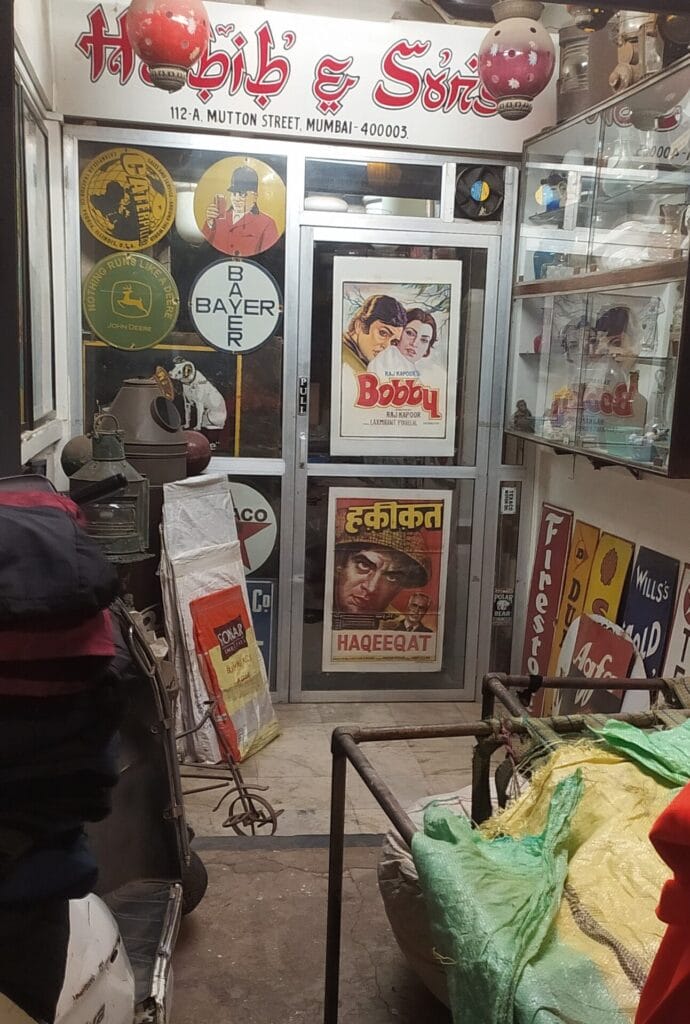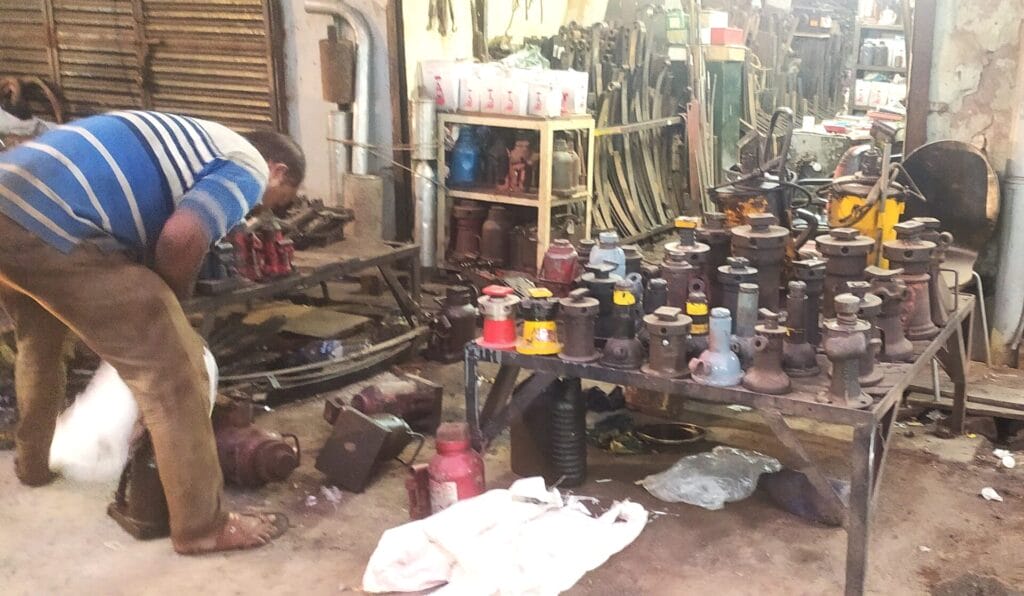Starting November, the first batch of shops from Chor Bazaar, Mumbai’s popular and unique market for antiques, artifacts and cheap vintage knick knacks, have started moving into their allotted spaces in the new Al-Ezz towers in Bhendi Bazaar.
A cloud of questions about if and how the new market will manage to retain its distinct identity in the new skyscrapers surrounds the shopkeepers, who have been there for generations.
About 122 shops from a part of Chor Bazaar will be shifted into the shopping arena of four 50-plus storied towers in the next few years, as part of the Bhendi Bazaar redevelopment project undertaken by the Saifee Burhani Upliftment Trust (SBUT).
The entire project spread across 16.5 acres comprises redevelopment of 1250 shops and 3200 families living in 250 dilapidated buildings.
Redevelopment and Chor Bazaar
The redevelopment process has been going on for the past decade. The nature of the antiques market shifted online with many shopkeepers sharing pictures of their wares n websites and WhatsApp groups and even offering home delivery.

“While some shopkeepers shifted to neighbouring lanes, a few moved online. The old shops had leakages, the gutters overflowed. But, a clean, hygienic environment in redeveloped shops should attract foreign tourists back,” says Mohammad Hussain Mansuri, a third generation dealer, who had shops selling posters of old films and old advertising campaigns.
Others like Farida Iqbal Mansoori, 60, who owned a shop dealing in antiques, has decided to stock contemporary showpieces in her new “modern” shop. “If so many families are moving into multi-storied apartments nearby, I am hoping to cater to their needs and purchasing capacity as well. While I am happy with the street-side shop that I have got, I think the customer base here would be quite different. We have already transitioned our antiques business from off-line to online mode and we shall continue it that way,’ says Farida.
A unique market with history
Chor Bazaar is an amalgamation of multiple streets near Grant Road specialising in selling specific wares like antiques (Mutton Street), furniture (Khara Tank Road), hardware, vehicle spares (Bara Imam Road) car tapes (Saifee Jubilee Street), Tiles (Duncan Street), Dedh Gali (shoes) and even used clothes.
Rajan Jaykar, an avid memorabilia collector, describes the market, which is operational from pre-independence times, as a repository of all things discarded and restored and resold.

While Mutton Street – where partial redevelopment has taken place – had shops selling artefacts and antiques attracting maximum foreigners. The other lanes have shops only in specific specialised wares like vehicle spares, leather, furniture or even hardware.
The Friday flea market is another distinct space, where used clothes, shoes, old grinders, blenders and even mobiles are sold by street vendors and attract the marginalised looking for affordable household things. Regular visitors say that the number of shops have drastically reduced and few shops have moved out to other businesses. The number of foreign tourists, the cream clientele, has drastically reduced over the years.
Efforts to retain Chor Bazaar’s identity
The SBUT says that it is trying to allocate shops selling similar wares in clusters to ensure that markets retain their distinctive flavour. “The shopping arenas of four 50-plus storied towers will be interconnected with skywalks at second levels to ensure seamless high-street shopping experience with modern amenities and facilities like elevators, escalators, parking lots and wide roads and trees-lined well-lit footpaths,” says an SBUT spokesperson. The shops will have a street-facing glass facade to display their wares.
Read more: The story of Mumbai’s Bhendi Bazaar: Redevelopment while conserving heritage
Bharat Gothoskar, founder of Khaki Tours, which organises walking tours in various parts of Mumbai, says that Chor Bazaar continues to attract visitors for walks as it is considered a must-see experience in Mumbai by first-time visitors. However, he feels that the Bhendi Bazaar redevelopment is an opportunity lost as it failed to retain its vibe and old-world charm of the market, its main attraction here, in the quest for redevelopment.
“Some aspects of the old buildings, maybe like a facade, could have been retained as a streetscape as is done in places like Singapore to give a sense of what the area was about. We have no sense of what we have lost as a city. Products like food and antiques can be ordered online but experiences can’t, ” he says. Bharat hopes that the Chor Bazaar can be recreated in a dedicated tourist zone within BPT land when it gets redeveloped.
Will customer, the king, come to the new market?
For Aadil Desai, an avid collector of vintage vinyl records, antiquarian books, maps and other antiques, the major attraction at Chor Bazaar was the joy of just strolling through and exploring the array of artefacts on display.
“Shopping at Chor Bazaar meant sifting out the genuine antiques from the duplicates, the skillful informed bargaining and the process of taking in the wide array of knick knacks on display. Though the shopkeepers these days do share updates about new and interesting arrivals on my WhatsApp, nothing beats the joy of just strolling around and touching and feeling genuine antiques or even rare books or film posters,” says Aadil.
Though the bylanes of the Chor Bazaar were narrow and dusty, it housed shops that offered unmatched services attracting passionate art collectors.

“There were shops that could repair antique watches. Another shopkeeper specialised in repairing vintage artefacts that needed regular care and upkeep,” observes Rajan Jaykar, who is also the curator of The Bombay High Court Museum. “But, such unique services are fading away as the next generation seems to have lost interest in carrying forward the traditional business.”
Rajan, has been a regular visitor here since the 1970’s and has picked up antique postcards, lampshades and even furniture over the years.
Both Aadil and Rajan now source artefacts online since the redevelopment process started. Both are keenly observing the developments to see how the market evolves.
Redevelopment of Bhendi Bazaar
“As the Bhendi Bazaar redevelopment project by SBUT gains momentum, demand for similar development is gaining ground in the neighbouring localities. We are making efforts to redevelop the area under cluster redevelopment to help transform it and get a new lease of life,” says Amin Patel, legislator from Mumbadevi constituency.
Cluster development of other commercial hubs like Kamathipura and Kalbadevi are also on the anvil. The Bhendi Bazaar project could be kickstarted because of the community-centred and not-for-profit approach by the Bohra community. Other cluster development projects by commercial developers are in the pipeline, he said.
While the Chor Bazaar continues to attract its patrons, tourists and art aficionados, both local and foreign, it remains to be seen if the charm of this unique market will continue in the new modernised setting.
| What have been your experiences shopping in Chor Bazaar before and during the redevelopment process? What does a redeveloped Chor Bazaar mean for you? Do share with us on mumbai@citizenmatters.in |